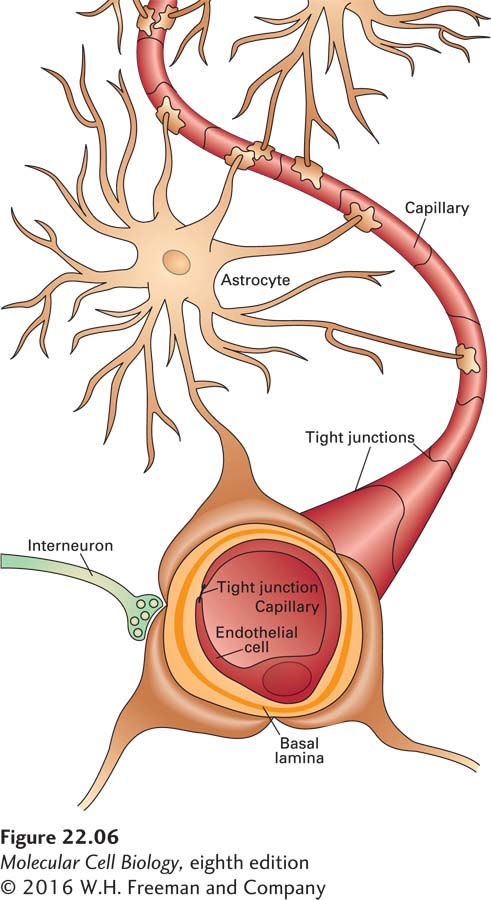Glial Cells Form Myelin Sheaths and Support Neurons
For all the impressiveness of neurons, they are not the only cells in the human brain. Glial cells (also known as neuroglia or simply glia), which play many roles in the brain but do not themselves conduct electrical impulses, are present in large numbers throughout the brain. While many textbooks claim that glia outnumber neurons by 10 to 1, recent experiments have suggested that the ratio of glia to neurons in the human brain is closer to 1:1, although there is significant variability between species and brain areas. For example, glia significantly outnumber neurons in the human cerebrum, while neurons greatly outnumber glia in the cerebellum. Of the four principal types of glia, two produce myelin sheaths—the insulation that surrounds neuronal axons (see Figure 22-1b): oligodendrocytes make sheaths for the central nervous system (CNS), and Schwann cells make them for the peripheral nervous system (PNS). (Both types of glia are discussed in more detail in Section 22.2.) Astrocytes, a third type of glia, provide growth factors and other signals to neurons, and also receive signals from neurons. A fourth type of glia, microglia, constitutes a part of the CNS immune system. While microglia are not related by lineage to neurons or to other glia, they do play important roles in brain development and health. In the next two paragraphs, we describe the function of astrocytes; oligodendrocytes and Schwann cells will be discussed in Section 22.2, and microglia in Section 22.3.
Astrocytes, named for their starlike shape (Figure 22-6), constitute about a third of the brain’s mass and up to 40% of the brain’s cells. Astrocytes surround many synapses and dendrites; the Ca2+, K+, Na+, and Cl− channels found in astrocyte plasma membranes influence the concentration of free ions in the extracellular space, thus affecting the membrane potentials of neurons and of the astrocytes themselves. Astrocytes produce abundant extracellular matrix proteins, some of which are used as guidance cues by migrating neurons, and a host of growth factors that carry a variety of types of information to neurons. They also release several factors that are necessary for proper synapse formation between neurons, as discussed in Section 22.3. Astrocytes are joined to each other by gap junctions (see Figure 20-21 for structure of gap junctions), so changes in ionic composition in a given astrocyte are communicated to adjacent astrocytes, over distances of hundreds of microns.

FIGURE 22-6 Astrocytes interact with endothelial cells at the blood-brain barrier. Capillaries in the brain are formed by endothelial cells that are interconnected by tight junctions that are impermeable to most molecules. Transport between cells is blocked, so only small molecules that can diffuse across plasma membranes or substances specifically transported through cells can cross the barrier. Certain astrocytes surround the blood vessels, in contact with the endothelial cells, and send secreted protein signals to induce the endothelial cells to produce a selective barrier. The endothelial cells (burgundy) are ensheathed by a layer of basal lamina (orange) and contacted on the outside by astrocyte processes (tan). See N. J. Abbott, L. Rönnbäck, and E. Hansson, 2006, Nature Rev. Neurosci. 7:41–53.
Some astrocytes are also critical regulators of the formation of the blood-brain barrier, the purpose of which is to control what types of molecules can travel out of the bloodstream into the brain and vice versa (see Figure 22-6). Blood vessels in the brain supply oxygen and remove CO2, and deliver glucose and amino acids, with capillaries found within a few micrometers of every cell. These capillaries form the blood-brain barrier, which allows passage of oxygen and CO2 across the endothelial cell wall but prevents, for example, blood-borne circulating neurotransmitters and some drugs from entering the brain. The barrier consists of a set of tight junctions (Chapter 20) that interconnect the endothelial cells that form the walls of capillaries. Surrounding astrocytes promote specialization of these endothelial cells, making them less permeable than those in capillaries found in the rest of the body.
